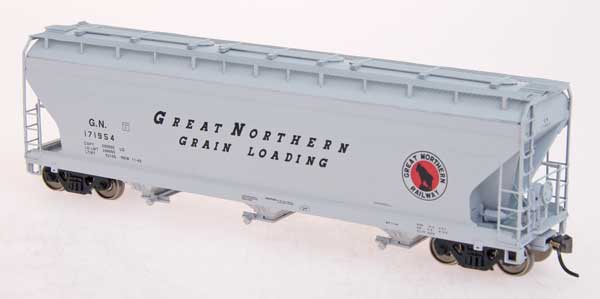C6 100 ton 4650 cubic foot grain service ACF covered hopper car, Light Gray. Built 1966.
Grain was the single most important commodity group to the Great Northern for decades. In the early 1960s the company began to acquire a large fleet of 100-ton net capacity covered hopper cars for grain transportation. Covered hopper cars were and are AAR car type LO, and 100-ton covered hopper cars were GST car type code C6 on the GN, regardless of cubic capacity.
Covered hopper cars for cement and other products that need to be kept dry had been in service since the 1920s. Great Northern purchased 405 nominal 75-ton 1958 cubic feet capacity cars for cement service between 1940 and 1953. In 1958 GN purchased another 100 nominal 75-ton, 2003 cubic feet capacity cars for cement service from Pullman-Standard.
Also in 1958, Great Northern purchased 50 covered hopper cars of 2,893 cubic feet capacity on nominal 70-ton trucks with a load limit of 77 tons for barley, feed, soybean and other bulk food commodity service. In 1960 the GN purchased 75 covered hopper cars of 3215 cubic feet with a load limit of 77 tons for the same service. In 1962 and 1963 70 cars of 4,000 cubic feet and 90-ton capacity joined the fleet. These cars too were intended for barley, feed, soybean and other bulk food commodity service. These were specialty cars for specialty service.
The first 100 net ton grain cars were Southern Railway’s ‘Big John’ cars of 1961 built to recapture feed grain traffic previously lost to truck-barge competition. They had a cubic capacity of 4700 cubic feet and were built of aluminum to minimize tare weight. The gross weight on rail limit of four axle cars was 251,000 pounds at that time. To meet that limit and carry 200,000 pounds they had to be built of aluminum, which was more expensive than steel. The ICC suspended Southern’s 60 percent lower rates it published to regain the traffic, which started a three-year war with the ICC, including two trips to the Supreme Court. Many observers credit the Big John case with publicly demonstrating the folly of preventing the railroads from competing for traffic.
Nominal 100-ton steel grain cars became possible only after 1963 when the AAR increased the allowable gross weight on rail by 5 percent, to 263,000 pounds for four axle cars having size F axles. Grain cars have a much larger cubic capacity than cars for cement service of equal tonnage capacity, because grain is less dense than cement which weighs 85 pounds per cubic foot. Wheat weighs 60 pounds per bushel, and corn is 56 pounds per bushel. One cubic foot is .803 bushels, so a cubic foot of wheat weighs 48.18 pounds, and a cubic foot of corn weighs 44.97 pounds; 200,000 pounds of wheat occupies 4151 cubic feet and of corn occupies 4447 cubic feet. Great Northern’s 4650 cubic foot cars could haul a full 100 tons of either corn or wheat. Compare this three-compartment grain car to two compartment cement cars of 100-ton and 2970 cubic feet capacity.
ACF was able to build its three compartment ‘Center Flow’ design cars with a tare weight of less than 63,000 pounds, so the car’s load limit was a bit over 200,000 pounds. The Center Flow design eliminated the traditional center sill which reduced tare weight and greatly improved unloading rate and reliability. Great Northern purchased 100-ton center flow cars to haul grain in 1964, 1965, 1966 and 1968.
Cars 171100 to 171149 of 1964 had a high mounted hand brake wheel, three roof hatches, and were delivered in light gray paint. Cars 171150 to 171249 of 1965 had a high mounted hand brake wheel, three roof hatches, and were delivered in light gray paint. Cars 171700 to 171999 of 1966 had a low mounted hand brake wheel, three roof hatches, and were delivered in light gray paint. Cars 170000 to 170299 of 1968 had a low mounted hand brake wheel, three roof hatches, and were delivered in Big Sky Blue paint.
Our InterMountain model is of cars built to ACF’s ‘Center Flow’ design. It is painted with the light gray body color that these cars were delivered in, and is appropriately stenciled with the ‘Great Northern Railway’ herald and a 1966 built date. The model is numbered in series GN 171700-999, which is a good number series, for the 300-car lot of 1966. Prototype GN cars had the ‘phase I’ body style with a horizontal stiffening rib across the upper portion of the car side as do these models.
This model fills an important place in Great Northern’s car fleet, since Great Northern purchased 1,000 light gray and 300 Big Sky Blue ACF center flow cars. The GN also bought 100-ton grain cars from other builders during the 1960s. The introduction of covered hopper cars was an important technological change in the grain trade and grain transportation. This model represents a mass-produced prototype of its time.
If you model the later years of GN, especially in Montana, the Dakotas, and Minnesota, you need several of these. You could reasonably spot them for loading at our Touhey elevator.




